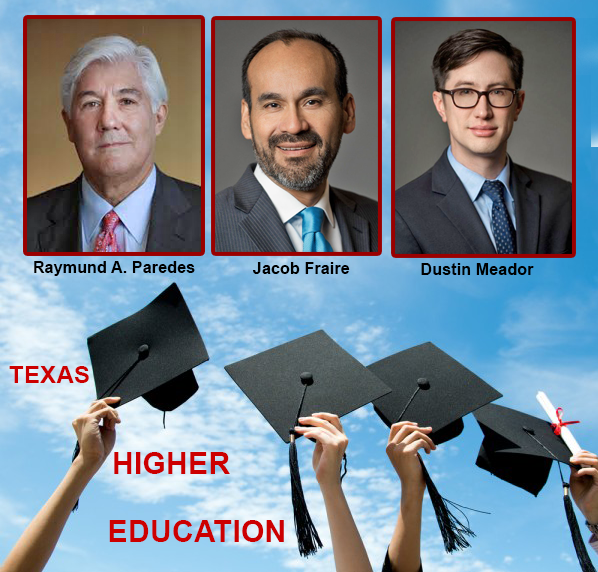
It took 140 days to decide how much funding and flexibility two-and-four-year educational institutions would receive. Higher education had a chilly reception at the beginning of the 85th Legislative Session when three bills were proposed that would have frozen all tuition and fees until 2022, repealed the tuition set-aside program and required schools to reach certain targets in 11 benchmark categories before being able to raise tuition and fees. Senate Bill 1 and House Bill 1, in the beginning, also didn’t fall too favorably in the direction of higher education. “The Legislative Session was a tough one for higher education, although the end result was not as severe as the first formulations of both the Senate and House budget,” said Texas Higher Education Commissioner Raymund A. Paredes. “Even before the Legislative Session began our member colleges, certainly here in this office, heard loud and clear from legislators that this was going to be a very tight fiscal year in the session and so we kind of just braced ourselves for a very tough funding session,” said Texas Association of Community Colleges President and CEO Jacob Fraire.
According to Fraire, the initial appropriations bill would have reduced formula funding for community colleges right at $6 million. The session ended, when all nickels were counted, with a net increase in formula funding of $19 million. “For us, that was not just a net positive in terms of dollars but it was really a reflection of how the legislature values Texas community colleges across the board so that was a very positive outcome for the 85th session,” said Fraire.
“I think that community colleges did pretty well and I think it was significant that the legislature really paid attention to the important role of community colleges and Texas state technical colleges in higher education so that was very gratifying,” said Paredes. The commissioner also shared the significance of the current biennium’s TEXAS (Towards EXcellence, Access and Success) Grant. The Texas Legislature established the program in 1999 to provide funds to academically prepared high school graduates with a financial need to pursue a higher education. “That is huge,” said Paredes. “We will be able to fund about 92 percent of admission eligible students each year in the coming biennium. “We also get a small increase of funding for the Texas Educational Opportunity Grant (TEOG) which is for community college students and that is good news.” The TEOG was created in 2001 to provide grant aid for tuition and required fees to financially needy students who enroll in Texas public two-year colleges.
 There was a significant drop in funding for emerging research universities called the Texas Research Incentive Program (TRIP) which provides matching funds to universities like The University of Texas (UT) at Dallas, Texas Tech, University of Houston and UT San Antonio. There was a significant drop in funding from $138 million to $35 million. “That is going to significantly slow down the building of these institutions to become Tier I research universities,” said Paredes. “That is something we are going to have to address during the interim.”
There was a significant drop in funding for emerging research universities called the Texas Research Incentive Program (TRIP) which provides matching funds to universities like The University of Texas (UT) at Dallas, Texas Tech, University of Houston and UT San Antonio. There was a significant drop in funding from $138 million to $35 million. “That is going to significantly slow down the building of these institutions to become Tier I research universities,” said Paredes. “That is something we are going to have to address during the interim.”
The downfall of transfer credits was another disappointing loss for higher education, according to Texas Association of Community Colleges Director of Government Relations Dustin Meador. Sen. Royce West had two bills on transfer credits but neither one made it to the governor’s desk. When community college students transfer to a four-year college their earned credits don’t always apply towards their chosen degree. “The credits might transfer but they don’t apply to a degree,” said Meador. “So they become excess and they have to repeat the course. This has been an ongoing issue for many sessions. We thought we were going to get closer this year and unfortunately received the same results. We did not begin the session actively seeking this policy, but there was a very strong sentiment among legislators that wanted to see transfer policy enacted.”
A bill that TACC proactively pushed was House Bill 2994, authored by Rep. Trent Ashby. The bill relates to workforce continuing education offered by public junior colleges, but the credit hours don’t necessarily lead to a degree. The bill ensures that colleges can receive state reimbursement for continuing education courses taught to high school students or with the tuition waived for adults. In some urban areas, these classes are offered to high school students as a dropout prevention technique. Community colleges might partner with a government or industry to offer workforce training courses.
Meador and Fraire say that TACC is going to look at overhauling the way dual credit is handled throughout Texas. There are approximately 150,000 high school students in the 2017-2018 academic year who are taking college courses while they are in high school. Of those students, 93 percent of them (ten percent of high school students) are taking their college courses at a community college. “This will be an interim project where we have multiple studies and task forces going on and our goal next session is to go in with recommendations to the Senate and the House to update the dual credit model,” said Meador. The student might take the dual credit class at their high school by a teacher who is an accredited professor or they will travel to the college for the class. There are several different models out there. The way that the college courses are paid for vary widely across the state. More wealthy districts will offer the dual-credit for free and while colleges that can’t afford to provide this incentive will charge the high school students tuition. Some may even provide the credit for free to students on the free and reduced lunch meal plan. “There are a variety of different payment methods,” said Meador. “The college and the school district decide who pays for what. Its kind of a wild west and that creates some tension. For instance, an ISD might border two community college districts and they have to compete for that ISD’S business. There are a lot of different ways it is funded and delivered across the state so we don’t know what an overhaul would look like, but it does put stresses on the service areas and the finances for smaller colleges. Some kind of uniformity needs to be put into place for the next session.”
Whether they are in wealthy or poorer areas, community colleges are funded through three pots of money from the state. Beginning two sessions ago, every college got a flat million dollar core operation funding over the biennium. This session, that actually increased by about $300,000 and change for each college. That funding is for the core operations which keeps the lights on. The largest pot of money is based on the contact hour. “This is unlike public education where the schools tell the state ‘we have this many students’ and they come up with a formula,” said Meador. “We kind of work backwards where the state says ‘we have this much money that we can spend on community colleges’ and then our contact hours determine how they distribute that across the 50 college districts.” The smallest piece of funding is performance based on success points. Roughly 89 percent is contact hours and the remaining 11 percent is success driven and that is where each college scores points on a series of metrics that includes graduating students or completing a math class. There’s identified milestones that students reach to achieve points and they are weighted so the colleges then get funded based on a three-year rolling average of those success points.
A success point should be given to enrollment at four-year universities since they have been steadily increasing, according to Paredes. “One of the things that troubled me about what happened during the session is I don’t think there was a significant recognition of the fact that Texas is one of the few states in the country whose college-age population is growing,” said Paredes. “Several states are experiencing dramatic decreases in their college-age population. We are going to have this growing population of young people and what we really need to do is nurture them and make sure they have educational and career opportunities that will make the state more economically competitive and will raise the quality of life. It is very hard to do that if we don’t fund enrollment growth.” Right now Texas is funding at higher levels but not relative to the growth in enrollment. The funding of a full-time student has been steadily going down for at least ten years and Paredes says that’s a bad trend.
If enrollment increases by 2,000 or 3,000 students per year, there needs to be added classroom space and hiring of more faculty. Texas A&M who has gone from an enrollment of about 50,000 ten years ago to about 60,000 now will need more of everything to meet those needs. “They are going to have to do more with less and if they can do it without raising tuition fees, I think we have done a pretty good job in Texas of maintaining the affordability of higher education,” said Paredes. “Despite all of the clamoring of increasing tuition fees, Texas is still in the middle of the pack in terms of the overall cost of going to a university and we are among the three least expensive in the country in terms of community colleges.”
A big plus for community colleges this session was Senate Bill 2118, that allows two-year universities that meet the criteria can offer bachelor’s degrees in the fields of applied sciences, applied technology and nursing. But this will not happen overnight because colleges will need to go through the Texas Higher Education Board for approval, get accreditation approval and hire faculty to get the program rolling. Three community colleges in the state that already offer four-year degree programs are Midland College, South Texas College and Brazosport College. They have been offering baccalaureate degree programs since 2003 and their success is what helped propel this bill to the governor’s desk. “I think if the coordinating board does it well, if we offer high standards for offering these degrees, and if we make sure that we are not necessarily replicating programs, this could be another pathway for students,” said Paredes, who felt that this was a very significant bill for higher education along with the increase in funding for the TEXAS grant.
How institutions are funded is something that Paredes would like to take a closer look at. “The formulas that we use have been in place for about 20 years and it is time to take another look at them and make sure they are as up to date as they should be. We need to look at the funding because some of these special items have been funded for 40 or 50 years and when does a special item just become part of the overall cost of offering an education for that particular institution. I think we probably need to figure out a way to fund special items as simply part of operating expenses of a given institution. We are going to have to take a look at the TRIP program and the state that it is in and we are going to have to ask very hard questions about how many top research universities we need and how many are we willing to fund.”
